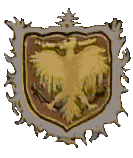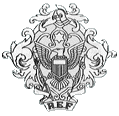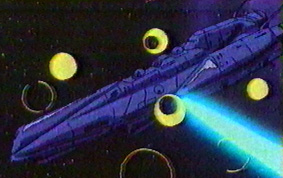 by Pieter Thomassen, with Peter Walker and Rob Morgenstern
by Pieter Thomassen, with Peter Walker and Rob Morgenstern
Names and Disposition:
The Banshee/Gremlin vessels were named after mythological monsters. The Robotech Defense Forces procured a total of 190 Banshee and 55 Gremlin class destroyers for the Armies of the Southern Cross, and a total of 102 Banshee class destroyers for the Expeditionary Forces. In total, 347 Gremlins and Banshees were produced in the L5 orbital factories, on Moonbase Luna and in the Yarrow aerospace yards from 2013 to 2033. Both classes served with the Southern Cross from 2021 to the Invid Invasion. The Banshee vessels with the Expeditionary Forces served from 2013 to 2045.
Of the Southern Cross vessels, 193 were destroyed by the Tirolian forces in the Second Robotech War, 37 were destroyed by the Invid in their initial invasion or during the occupation, and 15 ships deactivated themselves on various outposts such as the Saturn station and the Lunar bases to avoid detection and destruction by the Invid. These ships are now mothballed in the Tranquillity Sea storage depot.
Of the Expeditonary Forces vessels, 22 were destroyed prior to 2031, another 40 were destroyed by the Tirolian Forces after being send back to Earth in the various Earth Reclamation Force waves, 22 were destroyed in the Invid Invasion; the remaining 18 survived the third Robotech war in second-line duties and were mothballed after the war in 2045.
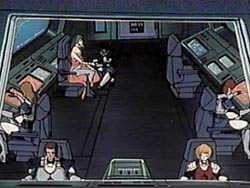
Ship's Complement:
- Ships' crew (30 men),
- 2 Mecha squadrons (68 (Southern Cross) to 75 (Expeditionary Forces) men),
- Life support limits are for a full combat complement and about 200 supernumaries (circa 300 men total).
Dimensions:
| |
|
• Length | : | 195.1 m over all. |
| • Height | : | 32.8 m over the main hull. |
| 41.4 m from the launch chute to the antennas. |
| • Width | : | 51.4 m over the main hull. |
| • Mass | : | 39,600 metric tons (Banshee class). |
| 42,340 metric tons (Gremlin class). |
• Fuel Mass | : |
7,500 metric tons, maximum (typical). |
Propulsion System:
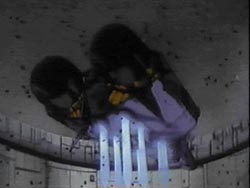
- Main power system: RRG Mk10 protoculture-fueled Reflex furnace. The powerplant of the Banshee- and Gremlin-class vessels can deliver up to 45.6 Terawatts of power, and can operate for thirty-nine minutes at maximum power before overheat initiates autoshutdown.
- Maneuvering thrusters (cluster) (11): Fusion-plasma reaction thrusters with steerable nozzles. Two are located on each side, six are mounted underneath the hull (with three thrusters each) and one is located on top of the vessel.
- Maneuvering thrusters (single) (12): Fusion-plasma reaction thrusters with steerable nozzles. Five are located on each side of the nose behind blast doors and two are in the side sponsons facing forward.
- Reaction-mass thrusters (3):
(Expeditonary Force and Southern Cross vessels pre-refit): 2 x Westinghouse RT-80M fusion-plasma reaction thrusters with protoculture energizer in the rear of the main hull and the sponsons.
(Southern Cross vessels post-refit): 2 x Westinghouse RT-80Q fusion-plasma reaction thrusters with protoculture energizer in the rear of the main hull and the sponsons.
(All ships)
Westinghouse KYDS-4 secondary fusion-plasma reaction thruster with protoculture energizer in the lower center rear of the main hull.
- Anti-gravity system (1): 2 RRG Atlas anti-gravity pods.
- Space fold (1): RRG SHJ-1 spacefold. This system generates a hull-conformal fold.
- Planetary capabilities:
The Banshee-class has atmospheric capabilities through its reaction thrusters and anti-gravity system. Five landing legs can extend from the lower main hull and support the vehicle, provided the ground surface can carry the load. If this is not so, then the hull has sufficient structural strength for the ship to make a belly landing on it.
The Gremlin class has the same landing leg system, but is not capable of belly landings without crushing the launch chute underneath the ship. Both ships will float in an ocean, but the main access ports in the lower hull will then be submerged.
Endurance and mobility limits:
- The dry stores endurance for a Banshee is one month maximum; after that, she needs to restock. The dry stores endurance of the Gremlin class is four months maximum. In both classes water stores are recycled almost totally, and many Gremlin crews added small hydroponic plants to unused spaces, providing the crew with a smattering of fresh fruits, but this was insufficient to provide for the crew for more than a few days.
- The mecha consumables supplies (mainly missiles) are limited; the destroyer is unable to sustain continuous combat operations for much more than twenty days. The Southern Cross, being less dependent on missiles and operating near Earth almost exclusively, used much of the magazines as additional berthing and storage spaces, and habitually carried supplies for five days of of continuous combat operations.
The missile magazines for the ship's own launchers are typically empty after one major space battle.
- The Reflex furnace can function for about 25 years at normal usage levels before an energizer rebuild is necessary.
- At full power, the main propulsion systems can produce up to 1.13 Giganewtons of thrust at a minimal reaction mass efficiency profile, or as little as 19.8 Meganewtons of thrust at a maximum efficiency setting. At lower power levels, these thrusts are commensurately smaller.
- At full power, the Banshee-class can achieve a maximum delta-v of 273 kps at the cruising acceleration of 0.1g, a maximum delta-v of 54.6 kps at the battle acceleration of 1.0g, and a delta-v of at most 15.3 kps at the flank acceleration of 2.5g. At lower power levels, these ranges are commensurately smaller.
The Gremlin class has a similar endurance, with a 16.6 percent penalty in delta-v due to the increased dry mass of the ships.
Refitted ships of the Southern Cross with the RT-80Q engines have an identical acceleration, but the engines are more efficient, which translates in a 21% better endurance than equivalent non-refitted vessels.
- The maximum sustained atmospheric speed is Mach 3. The maximum hover time on the anti-gravity systems is limited only by the protoculture supplies and maintenance requirements, but the system is too weak to lift the ship against gravities of more than 1.2g without assistance from the reaction thrusters. In fact, even at 1.0g the bottom-mounted maneuvering thrusters are often used to reduce the strain on the anti-gravity systems.
- The maximum sustained atmospheric speed is Mach 3. The maximum hover time on the anti-gravity systems is limited only by the protoculture supplies and maintenance requirements, but the system is too weak to lift the ship against gravities of more than 1.2 g without assistance from the reaction thrusters. In fact, even at 1.0 gravity the bottom-mounted maneuvering thrusters are often used to reduce the strain on the anti-gravity systems.
Weapon Systems:
Banshee vessels completed 2013-2015:
- ZNPC-01 (Makral Mossil 918) particle/laser cannon (1): These cannons were salvaged from wrecked Zentraedi vessels
after the First Robotech War, shipped to the Moon, and mounted on the Banshee vessels as Terran designed weapons of the required size and firepower were not available yet.
For centuries this combined particle beam and laser weapon had been the standard medium cannon armament on Zentraedi vessels. Two
different beam weapons (variable frequency laser and particle beam cannon) are provided on one mount so that the discharge medium can be chosen as the optimum for the local target and environment conditions. Both weapons have the same yield at the muzzle. The laser can be fired in a low power mode directly before the particle beam fires, this setting is typically used to burn a vacuum path for the particles through an atmosphere. The cannon has an effective range of 300,000 km. Each full-intensity shot has a yield of 1000 MJ, and the cannons can cycle through their firing sequence once every three seconds. One of these cannons was mounted in front of the command tower.
- RRG AML-10 laser cannons (6) : A somewhat bulky but effective anti-mecha and anti-missile laser weapon firing a 10
MJ pulse every second. Six of these weapons were mounted, two each on the superstructure, dorsal and ventral hull. These weapons and their on-mount sensors are protected by a folding hatch when not in use.
- Mk.249 MLS missile systems (2): This is a VLS missile system. Each system has three rows of 20 vertical launch tubes. The launchers cannot be reloaded except by lengthy extra-vehicular activity, effectively limiting the load-out for a battle to what had been placed in the launchers. The missiles typically used are the Warhawk and the Spacehawk. These are usually the standard HE, nuclear reaction anti-warship and nuclear reaction re-entry capable versions.
This armament fit was replaced on the production line from 2016 onwards, and existing ships were refitted to the following configuration:
All ships from commisioned from 2016 onwards:
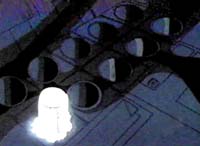
- Spacelord SMS-10 vertical missile launch system (3 for Banshee, 5 for Gremlin): A vertical launch system that fires medium anti-ship missiles and consist of two rows with five launch tubes for Spacelord missiles. The launcher is fed from a hull magazine containing 20 reload missiles for a total of 90 missiles. The typical warheads are 150 kT reaction warheads for anti-ship use, a plasma device or a high explosive directed energy warhead.
These missile system are located forward of the upper cannons (1) and firing sideways from the side sponsons (2). The Gremlin mounts an additional two in the lower hull, before the mecha release chute.
(Expeditionary Force and Southern Cross pre-refit vessels)
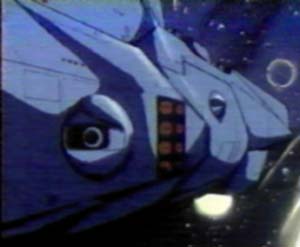
- RRG PB-4 particle turret (5): A fast firing medium calibre particle beam cannon in a low lying round turret. The cannon can fire 400 MJ of particle energy per second as short duration beams or as enclosed particle packets ('disks') with an effective range of 100,000 km. This cannon is not quite capable enough to be effective against larger ships than Tou Redirs, Re-entry pods, Assault Carriers or Mollusk carriers.
There are two on the upper hull, two on the forward hull sides, and one on the ventral hull.
(Southern Cross post-refit vessels):

- RRG PB-4b particle turret (6): The PB-4b is an improved version of the PB-4 with a protruding muzzle and greater reliability. The operational characteristics are further identical.
There are two on the forward hull sides, one on the upper hull, two on the side sponsons and and one on the ventral hull.
- RRG PB-5 particle turret (1): A twin barreled version of the PB-4b, with twice the firepower, mounted forward on the upper hull.
(All):
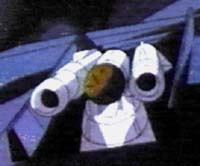
- RRG RG-2 Point Defense turret (2): The RG-2 mount is designed to deliver heavy firepower on very close targets. A double barreled rail gun with a round sensor between the barrels, the RG-2 is stored inside the hull, but elevates upwards from under movable panels into firing position. The RG-2 fires 0.227 kg KPI rounds at 25 kps, giving the rounds a kinetic impact energy of 71 MJ. Maximum effective range for this system is 20 km against mecha sized targets, maximum rate of fire is 120 rounds per minute.
Two of these cannons are mounted in the superstructure.
- Oerlikon PD-2 Point Defense turret (3): The PD-2 is a double-barreled laser cannon, with an on-mount multi-spectral sensor. Designed for point defense against mecha, missiles and small vessels, the PD-2 delivers 50 MJ of laser energy four times per second.
Two are mounted on the dorsal hull and one on the ventral hull, behind movable panels.
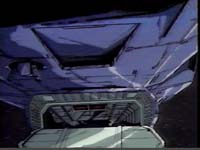
Air Group and Mecha Complement:
(Banshee class)
(Gremlin class)
Note: The Banshee can accommodate 12 additional fighters by using the launch bay as an additional hangar, with the mecha tied down for storage rather than in stalls. However, this was universally unpopular with the pilots as recovery of the additional fighters was not possible, unless a loss rate of 33% was exceeded. Adverse effects on morale effectively killed the method.
The Southern Cross occasionally used Veritech Hovertanks if other, more usual space combat mecha were in short supply.
Design Notes:
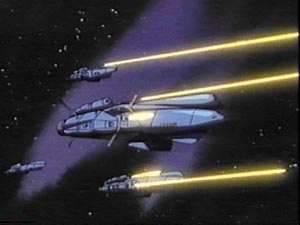
These ships were jacks-of-all-trades. As the smallest major combatants available, they aid larger ships with mecha defense and add
their anti-ship firepower to that of the larger ships. There were two versions of the same basic design. The Banshee class is a general purpose destroyer, the Gremlin class mounts additional missiles, replacing half the mecha complement in compensation.
Banshee's had a hull form resembling a Second World War submarine, as with the hulls of their larger contemporaries. However, there
was no conning tower, but a raised deck at the back, the front of which housed the main bridge. Beginning at about half length, there were also two side sponsons that housed the main engines. The Banshees and Gremlins featured a two level fighter hangar amidships. In the Banshee, a large release chute is built into the lower nose, protruding slightly below the keel. In the Gremlin, the mecha release chute was mounted in a bottom-mounted sponson, which made the Gremlin incapable of belly landings without crushing this chute without proper ground bracing to accommodate the chute protrusion.
The armament was mounted to cover all arcs, with priority given to the upper forward sector. In a refit that was ongoing throughout the second Robotech War, the Southern Cross modified the main engines to the RT-80Q standard, which was more efficient in its fuel use. In addition, an additional two particle beam turrets were installed in the side sponsons, and all turrets were upgraded to the more reliable PB-4b system, and one turret was replaced with a PB-5 turret, although the new turrets were not yet available in quantity at the beginning of the 2nd Robotech War and some craft temporarily mounted 7 PB-4 turrets instead. All ships mounted three or five Spacelord anti-ship missile systems.
History:
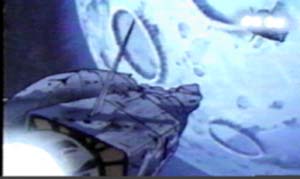
After the Zentraedi Holocaust and the Malcontent Uprisings, the Robotech Defense Forces started rebuilding the Terrestrial
defenses and assembling the Expeditionary Force. During this period, two almost identical requirements surfaced; one for a medium destroyer capable of engaging a Tou Redir sized and armed ship and one for a medium destroyer with additional missile armament to support larger anti-ship patrols. The Defense department therefore combined these requirements and the results were the Banshee and Gremlin classes, the first one being built in larger numbers. Relatively few compromises were required, as the different requirements could be addressed by designing two slightly different versions of the same ship. In a later refit (to which new units were built from 2028 onward), the Armies of the Southern Cross expanded the particle beam firepower of its ships by upgrading the existing cannons, adding two more and replacing one with a doubled version. The Expeditionary Forces did not use the Gremlin class, as the Banshee, with its larger mecha complement, provided more flexibility.
Although designed to fight the Zentraedi, the destroyers' most important and best known battles were waged against the Robotech Masters and later against the Invid. The comparable vessel in the Tirolian Forces was the Tirolian Assault Carrier, a vessel far superior in mobility and versatility to the Terran design. However, the destroyers were part of mixed battlegroups, and relatively few exclusively Assault Carrier vs. destroyer encounters were fought, usually with regrettable results for the Earth forces. Against the heavier Tirolian ships such as destroyers and the Motherships themselves the results of Banshee/Gremlin actions were usually disastrous for the Terran destroyers.
After the heavy losses of the Second Robotech War (in which 70% of all destroyers were lost), the classes had little resistance to offer against the Invid, whose numerical tactics were ill-suited to the Banshees and Gremlins anyway. A number of these ships were in the outer reaches of the system and thus escaped destruction (10 vessels) or managed to flee the Invid assault (5 vessels) by folding into interplanetary space. However, as their supplies dwindled, these fifteen ships were forced to alight at the Saturn or Lunar bases, which had sufficient life support capability to last the crews for decades. Before these ships were shut down to avoid attracting Invid attention, though, they were used to evacuate the Uranus, Neptune, Pluto and Jupiter outposts, which were not sufficiently self-supportive. As a result, no personnel of these bases were present when the life support in the bases ran out of resources.
The few remaining vessels with the Expeditionary Force were no longer considered front line vessels, and served as guard vessels for the Factory Satellites or as command vessels for planetary raids. All surviving vessels were laid up immediately after the war.
See Image Gallery.
See additional design notes.
Return to Southern Cross naval index.
Return to REF naval index.
Go to Robotech Reference Guide Home Page.
Robotech (R) is the property of Harmony Gold. This document is in no way intended to infringe upon their rights.
Content by Pieter Thomassen, with Peter Walker and Rob Morgenstern
HTML by Robert Morgenstern (rmorgens@ieee.org)
Copyright © 2003, 2001, 2000, 1998, 1997, 1995 Robert Morgenstern, Pieter Thomassen, Peter Walker


